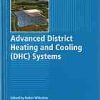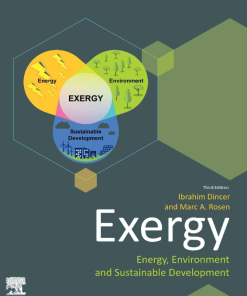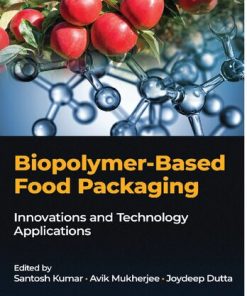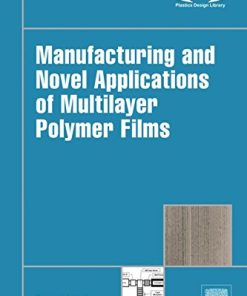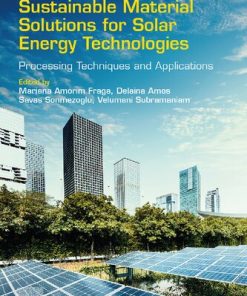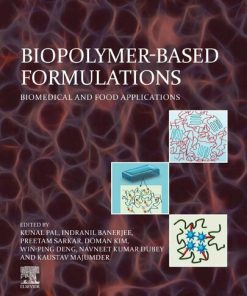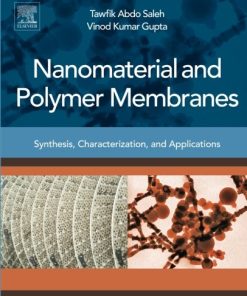Biopolymer Membranes and Films Health Food Environment and Energy Applications 1st Edition by Mariana Agostini De Moraes, Classius Ferreira Da Silva, Rodrigo Silveria Vieira 0128181355 9780128181355
$50.00 Original price was: $50.00.$25.00Current price is: $25.00.
Biopolymer Membranes and Films: Health, Food, Environment, and Energy Applications 1st Edition by Mariana Agostini De Moraes, Classius Ferreira Da Silva, Rodrigo Silveria Vieira – Ebook PDF Instant Download/DeliveryISBN: 0128181355, 9780128181355
Full download Biopolymer Membranes and Films: Health, Food, Environment, and Energy Applications 1st Edition after payment.
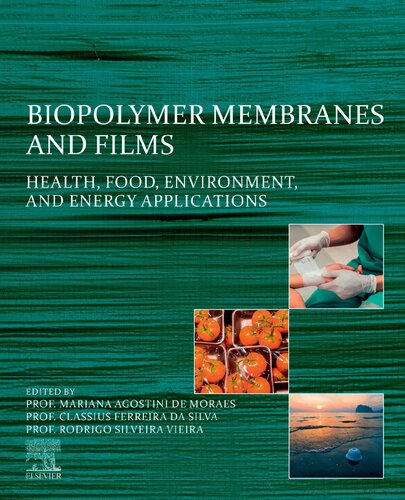
Product details:
ISBN-10 : 0128181355
ISBN-13 : 9780128181355
Author: Mariana Agostini De Moraes, Classius Ferreira Da Silva, Rodrigo Silveria Vieira
Biopolymer Membranes and Films: Health, Food, Environment, and Energy Applications presents the latest techniques for the design and preparation of biopolymer-based membranes and films, leading to a range of cutting-edge applications. The first part of the book introduces the fundamentals of biopolymers, two-dimensional systems, and the characterization of biopolymer membranes and films, considering physicochemical, mechanical and barrier properties. Subsequent sections are organized by application area, with each chapter explaining how biopolymer-based membranes or films can be developed for specific innovative uses across the health, food, environmental and energy sectors.
Biopolymer Membranes and Films: Health, Food, Environment, and Energy Applications 1st Table of contents:
Part I: Fundamentals on biopolymers membranes and films
Chapter 1: Fundamentals on biopolymers and global demand
1. Introduction
2. Polysaccharides and proteins: General characteristics
2.1. Polysaccharides
2.1.1. Alginate
2.1.2. Cellulose
2.1.3. Bacterial cellulose
2.1.4. Chitin and chitosan
2.1.5. Gellan gum
2.1.6. Hyaluronic acid
2.1.7. Carrageenan
2.1.8. Starch
2.1.9. Dextran
2.1.10. Agarose
2.1.11. Pectin
2.2. Proteins
2.2.1. Collagen and gelatin
2.2.2. Silk fibroin
2.2.3. Sericin
2.2.4. Soy protein
3. Applications of the membranes of biopolymers
3.1. Biomedical applications
3.2. Food
3.3. Environment
3.4. Energy
4. Global demand and market for biopolymers
5. Final remarks
Acknowledgments
References
Glossary
Chapter 2: Fundamentals of two-dimensional films and membranes
1. General aspects of membranes and films
2. Processing
2.1. Dense membranes
2.1.1. Casting
2.1.2. Extrusion/film blowing
2.1.3. Coating
2.1.3.1. Spread coating
2.1.3.2. Spray coating
2.1.3.3. Dipcoating
2.1.4. Layer by layer
2.2. Porous membranes
2.2.1. Solvent casting and particulate leaching
2.2.2. Thermally induced phase separation
2.2.3. Electrospinning
3. Modification approaches
3.1. Plasticization
3.2. Cross-linking
3.3. Composites
3.3.1. Silicate layers
3.3.2. Carbon nanotubes
3.3.3. Cellulose nanocrystals
3.4. Blending
3.5. Ionic liquids
4. Final remarks
References
Chapter 3: Characterization of biopolymer membranes and films: Physicochemical, mechanical, barrier,
1. Introduction
2. Physicochemical characterization
2.1. Microscopy
2.1.1. Optical microscopy
2.1.2. Scanning electron microscopy
2.1.3. Transmission electron microscopy
2.1.4. Atomic force microscopy
2.2. Fourier transform infrared spectroscopy
2.3. Raman spectroscopy
2.4. Nuclear magnetic resonance
2.5. X-ray diffraction analysis
2.6. X-ray photoelectron spectroscopy
2.7. Thermal analysis
2.7.1. Thermogravimetry
2.7.2. Differential scanning calorimetry
2.7.3. Dynamic mechanical analysis
3. Physical characterization
3.1. Swelling degree
3.2. Degradation/erosion degree
3.3. Mechanical properties
3.4. Barrier properties
3.4.1. Volumetric methods
3.4.2. Gravimetric methods
3.4.3. Differential methods
3.4.4. Microbial penetration
3.5. Contact angle
3.6. Textural analysis
4. Biological characterization
4.1. Cytotoxicity, sensitization capacity, and irritation potential
4.2. Antimicrobial activity
5. Conclusions
Acknowledgment
References
Chapter 4: Diffusion process through biodegradable polymer films
1. Introduction
2. Natural polymers
3. Polysaccharide based films
4. Proteins based films
5. Active films
6. Natural polymer diffusion mechanism
6.1. Mass transfer and diffusion
6.2. Mathematical modeling for the diffusive process in natural polymer films
6.3. Diffusive process in natural polymers
7. Conclusions
Acknowledgments
References
Chapter 5: Separation processes with (bio)membranes: Overview and new phenomenological classificatio
1. Introduction
2. Fundamentals
2.1. General physical and structure of the membranes
2.2. Membrane feed flux: Frontal and tangential
2.3. Modules of membranes
2.4. Preliminary general description of the separation processes with membranes
3. Advantages and disadvantage of the separation processes with membranes
3.1. Advantages
3.2. Disadvantage
4. Usual classification of the separation processes with membranes: Dimensional
5. Some basic concepts
5.1. Flux and permeability
5.2. Driving forces
5.3. Selectivity
6. Description of separation processes with membranes
6.1. Differential pressure as driving force
6.1.1. Microfiltration
6.1.2. Ultrafiltration
6.1.3. Reverse osmosis
6.1.4. Nanofiltration
6.2. Difference of concentration as driving force
6.2.1. Dialysis
6.3. Difference of voltage as driving force
6.3.1. Electrodialysis
6.4. Difference of partial pressure as driving force
6.4.1. Gas permeation
6.5. Difference of vapor pressure as driving force
6.5.1. Pervaporation
7. New classification of separation processes with membranes
8. Conceptual conclusion
Mechanical unit operations
Diffusional unit operations
9. Consequence of proposed classification for experimentation
10. Biopolymers
11. Future trends
References
Part II: Applications of biopolymers membranes/films in health
Chapter 6: Biopolymer membranes in tissue engineering
1. Introduction
2. Basic concepts of membrane characteristics envisioning tissue-engineering applications
3. Biomedical applications of membranes
3.1. Wound dressing
3.2. Drug delivery
3.3. Peripheral nerve regeneration
3.4. Cartilage regeneration
3.5. Guided bone tissue regeneration
3.6. Other tissues
4. Final remarks
Acknowledgments
References
Glossary
Chapter 7: Biopolymer-based films and membranes as wound dressings
1. Introduction
2. Characteristics of skin lesions
3. Major requirements to be fulfilled by wound dressings
4. Types and properties of biopolymers used in wound dressings
4.1. Chitosan
4.2. Alginates
4.3. Xanthan gum
4.4. Bacterial cellulose
4.5. Hyaluronan
4.6. Collagen
4.7. Gelatin
4.8. Silk fibroin
4.9. Keratin
5. Blends, composites, and associations with other bioactive agents
5.1. Blends
5.2. Composites
5.3. Association with bioactive agents
6. Final remarks
References
Chapter 8: Recent advances in biopolymer-based transdermal patches
1. Introduction
2. Transdermal drug delivery systems
2.1. Biopolymer-based transdermal films and patches
2.1.1. Chitosan based on transdermal films and patches
2.1.2. Pectin based on transdermal films and patches
2.1.3. Ethyl cellulose based on transdermal films and patches
2.1.4. Other biopolymers used in transdermal films and patches
2.2. Biopolymer-based microneedle patches
2.2.1. Hyaluronic acid/sodium hyaluronate based on dissolving microneedles
2.2.2. Carboxymethyl cellulose based on dissolving microneedles
2.2.3. Chitosan based on dissolving microneedles
2.2.4. Gelatin based on dissolving microneedles
2.2.5. Silk fibroin based on dissolving microneedles
2.2.6. Chondroitin sulfate based on dissolving microneedles
2.2.7. Miscellaneous biopolymer-based dissolving microneedles
2.3. Biopolymer-based nanofiber mats
3. Conclusion
References
Chapter 9: Fundamentals and biomedical applications of biopolymer-based layer-by-layer films
1. Overview
2. Principles of LbL film assembly
3. Antimicrobial LbL films
3.1. Antimicrobial surface approach
3.2. Antibacterial and antifungal surfaces
4. LbL films for sensing applications
5. Tissue engineering applications via LbL technique
5.1. Surface functionalization and TE applications
5.2. Multilayered cell scaffolds for TE applications
6. LbL films for drug delivery applications
7. Gene delivery applications for LbL films
8. Combination of LbL with other molecular assemblies
8.1. Micelles
8.2. Liposomes
9. Conclusions and future challenges
Acknowledgments
References
Chapter 10: Biopolymer membranes for dentistry applications
1. Introduction
2. Biopolymer membranes and films in dentistry
2.1. Natural and synthetic biopolymers
2.1.1. Collagen
2.1.2. Chitosan
2.1.3. Gelatin
2.1.4. Cellulose and derivatives
2.1.5. Hyaluronic acid
2.1.6. Poly(lactic-co-glycolic acid)
2.1.7. Other polymers
2.2. Blends, composites, and hybrid membranes
2.2.1. Blends
2.2.2. Silver nanoparticle composites
2.2.3. Hydroxyapatite composites
2.2.4. Calcium phosphate composites
2.2.5. Bioactive glass composites
2.2.6. Hybrid films
3. Treatments employing biopolymers
3.1. Endodontic therapy
3.2. Extractions, implants, and bone regeneration
3.3. Periodontology
3.4. Oral cancer treatment
3.5. Prosthetic dentistry
3.6. Caries prevention
3.7. Release of anesthetics
4. Drug delivery systems in the oral environment
4.1. Antimicrobial and antiinflammatory drugs
4.2. Anesthetics
4.3. Bone- and tissue-healing agents
5. Final considerations and future perspectives
References
Chapter 11: Biopolymer-based coatings for cardiovascular applications
1. Introduction
2. Biopolymers used for cardiovascular applications
3. Chemical modification of chitosan: Sulfonation reaction
4. Hemocompatible properties of sulfated chitosan
4.1. Protein adsorption on raw and sulfated chitosan
4.2. Platelet adhesion on raw and sulfated chitosan
5. Sulfated chitosan-based coating on metal surfaces
5.1. Sulfated chitosan-based coating on stainless steel
5.2. Chitosan-heparin nanoparticle coating on NiTi alloys
6. Challenges using natural polymer coatings on metal surfaces
References
Chapter 12: Orally disintegrating films of biopolymers for drug delivery
1. Introduction
2. Biopolymers used to produce orally disintegrating films
2.1. Production methods of orally disintegrating films
2.2. Innovative production methods of orally disintegrating films
3. Characterization of orally disintegrating films
3.1. Disintegration time
3.2. Mucoadhesion
3.3. Surface pH
3.4. Dissolution of orally disintegrating films
4. Conclusion
References
Chapter 13: Skin rejuvenation: Biopolymers applied to UV sunscreens and sheet masks
1. Introduction
2. Physiological effects of UV exposure
2.1. Aging
2.2. Immune system
3. Skin structure and phototype
4. Sun exposure and sunscreen protection
5. Sheet masks and biopolymers
6. Conclusion
Acknowledgments
References
Part III: Application of biopolymers membranes/films in environment and energy
Chapter 14: Heavy metal removal from industrial effluents using biopolymer membranes
1. Introduction
2. Chitosan
2.1. Obtaining chitosan membrane adsorbents
2.1.1. Chemistry of chitosan
2.1.2. Chitosan-based membranes
2.1.2.1. Blended chitosan membranes
2.1.2.2. Supported chitosan membranes
2.1.2.3. Composite membrane
3. Cellulose
3.1. Chemistry of cellulose
3.2. Cellulose modification
3.3. Cellulose-based membranes
4. Carrageenans
4.1. Chemistry of carrageenan
4.2. Carrageenan modification
4.3. Carrageenan-based membranes
5. Alginate
5.1. Chemistry of alginate
5.2. Alginate modification
5.3. Alginate-based membranes
6. Conclusions
References
Chapter 15: Pesticide removal from industrial effluents using biopolymeric materials
1. Introduction
2. Overview of pesticides
2.1. Classification
2.1.1. Classification based on pesticide toxicological behavior
2.1.2. Classification based on pesticide biological targets
2.1.3. Classification based on pesticide chemical structure
2.2. Characteristics of pesticides and their environmental fates after application
3. Biopolymers used in the removal of pesticides
4. Conclusions and future perspectives
Acknowledgments
References
Chapter 16: Dye removal from effluents using biopolymer membranes
1. The importance of dye removal from effluents
1.1. Dyes: Classification and uses
1.2. Environmental and public health risks
1.3. Guidelines for discharge of colored effluents
1.4. Methods for dye removal from effluents
2. Biopolymer membranes for dye removal
2.1. Biopolymers used for membrane preparation
2.2. Raw materials for biopolymer-based membrane preparation
2.3. Characterization techniques
2.4. Laboratory experiments using membranes for dye removal
2.5. Evaluation of membrane performance
2.6. Comparative analysis of several biopolymer membranes for dye removal
2.7. Real applications (real industrial effluents)
2.8. Perspectives and challenges
References
Chapter 17: Pharmaceutical and synthetic hormone removal using biopolymer membranes
1. Pharmaceutical and synthetic hormone removal
2. Fabrication of membranes and biomembranes
2.1. Biopolymers used in membrane manufacturing
2.1.1. Biopolymers derived from bacterial fermentation products used for manufacturing membranes
2.1.1.1. Polylactic acid
2.1.1.2. Polyhydroxyalkanoates
2.1.1.3. Poly(butylene succinate)
2.1.2. Biopolymers derived from vegetable sources used for manufacturing membranes
2.1.2.1. Cellulose-based polymers
2.1.2.2. Alginate
2.1.2.3. Polyisoprene
2.1.2.4. Starch and cyclodextrins
2.1.3. Biopolymers derived from animal sources used for manufacturing membranes
2.1.3.1. Chitosan
2.1.3.2. Collagen
2.1.3.3. Silk
2.2. Biopolymer-metal-organic framework
2.3. Membranes and biomembranes produced by electrospinning process
2.4. Molecularly imprinted membranes and biomembranes
3. Theoretical factors considered for membrane separation
3.1. Analysis of the adsorption equilibrium
3.2. Adsorption kinetics
4. Removal pharmaceuticals and hormones
5. Conclusions and future outlook
References
Further reading
Chapter 18: Biopolymer membranes in fuel cell applications
1. Introduction
2. Fuel cells
2.1. Alkaline fuel cells (AFCs)
2.2. Phosphoric acid fuel cells (PAFCs)
2.3. Solid oxide fuel cells (SOFCs)
2.4. Molten carbonate fuel cells (MCFCs)
2.5. Direct carbon fuel cells (DCFCs)
2.6. Proton exchange membrane fuel cells (PEMFCs)
2.7. Direct methanol fuel cells (DMFCs)
2.8. Biofuel cells (BFCs)
3. Biopolymer membranes for fuel cells
3.1. Chitosan (CS)
3.1.1. Self-cross-linked and salt-complexed chitosans
3.1.2. Chitosan-based polymer blends
3.1.3. Chitosan/inorganic filler composites
3.1.4. Chitosan/polymer composites
3.2. Cellulose (C)
3.2.1. Pure cellulose
3.2.2. Cellulose acetate
3.2.3. Cross-linked cellulose-based membranes
3.2.4. Cellulose-based graft copolymers
3.2.5. Cellulose-based materials doped with inorganic/organic compounds
3.2.6. Cellulose-based polymer composites
3.3. Alginate
3.4. Starch
3.5. Pectin
3.6. Agar
3.7. Gelatin
4. Summary and future perspectives
References
Chapter 19: Biopolymer membranes for battery applications
1. Introduction
1.1. Ionic dopant/salt effects on biopolymers
1.2. Biopolymers incorporated with a plasticizer
2. Preparation of biopolymer membranes
3. Characterization of biopolymer membranes for batteries
3.1. Electrical impedance spectroscopy
3.1.1. Equivalent circuit model
3.1.2. Ionic conductivity
3.1.3. Dielectric properties
3.1.4. Ionic conduction mechanism
3.2. X-ray diffraction
3.3. Fourier transform infrared spectroscopy
3.4. Transference number measurement
4. Biopolymer membranes in the battery
4.1. Operating principle of a battery
4.2. Characterization of battery performance
4.2.1. Open circuit voltage
4.2.2. Discharge characteristics
4.2.3. Rechargeability
5. Conclusions and future prospects
References
Part IV: Applications of biopolymers membranes/films in food
Chapter 20: Application of edible biopolymer coatings to extend the storage life of fresh fruits and
1. Introduction
2. Materials
3. Some biopolymers used in the production of edible coatings
4. Edible coatings and active edible coatings
4.1. Edible coatings
4.2. Active edible coatings
5. Considerations
References
Chapter 21: Application of edible biopolymer coatings on meats, poultry, and seafood
1. Introduction
2. Meats, poultry, and seafood spoilage
3. Edible coatings and films
4. Materials used for edible coatings and films
4.1. Polysaccharide-based edible film
4.1.1. Alginate
4.1.2. Cellulose and derivatives
4.1.3. Chitosan
4.1.4. Pectin
4.1.5. Starch
4.2. Protein-based edible coating and films
4.2.1. Corn zein
4.2.2. Gelatin
4.2.3. Wheat gluten
4.2.4. Whey protein
4.3. Composite edible coatings and films
5. Active components incorporated in edible films and coatings to meats, poultry, and seafood
6. Effect of edible films and coatings on quality of meats, poultry, and seafood
7. Conclusion
Acknowledgments
References
Chapter 22: Oxygen scavenging films and coating of biopolymers for food application
1. Introduction
2. Oxygen scavenging technology
2.1. Oxygen scavenging films
3. Oxygen scavenging agents
3.1. Iron and other metallic scavengers
3.2. Ascorbic acid and other natural OS agents
3.3. Enzymatic scavengers
3.4. Photosensitive dyes
3.5. Unsaturated hydrocarbons
3.6. Immobilization of microorganisms
4. Technologies for the preparation of oxygen scavenging films
4.1. Coating
4.2. Incorporation into packaging
4.3. Multilayer active films
4.4. Immobilization
5. Recent developments in oxygen scavenging films
5.1. Nanomaterials as oxygen scavenging systems
6. Future trends and conclusions
Acknowledgments
References
Chapter 23: Biopolymers applied as ethylene-scavenging films and coatings
1. Introduction
2. Climacteric and nonclimacteric crops
3. Ethylene importance
4. Conventional methods for ethylene scavenging
4.1. 1-Methylcyclopropene
4.2. Potassium permanganate
4.3. Adsorbent materials used in ethylene scavenging systems
5. Biopolymer films for ethylene control
5.1. Edible coating systems
5.2. Packaging film systems
6. Conclusion
Acknowledgment
References
Chapter 24: Edible films and coatings made up of fruits and vegetables
1. Introduction
2. Fruit and vegetable-based films and coating technology
3. Current research and product development
4. Future trends
References
Chapter 25: Probiotic-containing edible films and coatings of biopolymers
1. Introduction
2. Probiotics and prebiotics
2.1. Definitions
2.2. Beneficial effects on human health
2.3. Issues on the use of probiotics in food
2.3.1. Chemical, biochemical, and microbial activities of probiotics in polymeric matrices
2.3.2. The use of probiotics in bioactive packaging
3. Edible films and coating biopolymers containing probiotics
3.1. Polymeric matrices
3.1.1. Plant-derived biopolymers
3.1.1.1. Starch and derivatives
3.1.1.2. Cellulose and derivatives
3.1.1.3. Pectin
3.1.1.4. Alginate
3.1.1.5. Arabic gum
3.1.2. Animal-derived biopolymers
3.1.2.1. Chitosan
3.1.2.2. Gelatin
3.1.2.3. Casein
3.1.2.4. Whey protein
3.1.3. Microbial derived biopolymers
3.1.3.1. Dextran
3.1.3.2. Gellan
3.1.3.3. Xanthan
3.1.3.4. Microbial alginate
3.2. Methods of probiotic incorporation
3.2.1. Entrapment
3.2.2. Encapsulation
3.2.2.1. Microencapsulation
3.2.2.2. Nanoencapsulation
3.3. Probiotics release from polymeric matrices
3.3.1. Control of microbial growth
3.3.2. Microbial survival
3.3.3. Metabolic activity
4. Regulations on the use of probiotics in the food industry
5. Conclusion
People also search for Biopolymer Membranes and Films: Health, Food, Environment, and Energy Applications 1st:
biopolymer packaging
biopolymer films
biopolymer in food industry
biopolymer membranes and films
biopolymers films
Tags: Biopolymer Membranes, Films, Health, Food, Environment, Energy Applications, Mariana Agostini De Moraes, Classius Ferreira Da Silva, Rodrigo Silveria Vieira
You may also like…
Technique - Energy: Renewable Energy
Biography & Autobiography - Business & Finance
Technique - Energy: Renewable Energy


